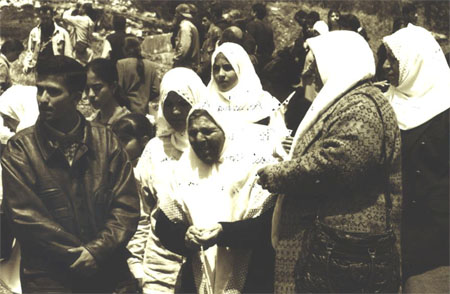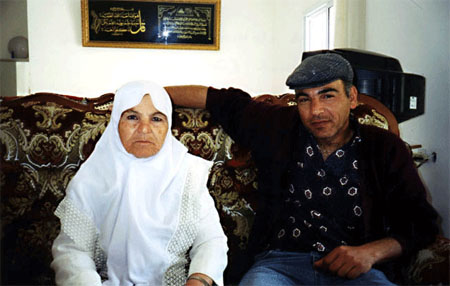
Umm Salah al-Yassini on her balcony. Ras al-Amood (Jerusalem)
April 2000
|
 Umm Salah al-Yassini on her balcony. Ras al-Amood (Jerusalem) April 2000 |
Hajji Umm Salah 'Yassini', Ras al-Amood, 14 April:
|
 Mourners at the commemoration of the massacre of Deir Yassin, April 1999. Umm Salah Yassini is in the foreground. |
|
Outside the door of Umm Salah from Deir Yassin, there's a panel embroidered with the words 'Kay la ninsa' (Lest we forget). Every year on April 9 the survivors of this most famous of the massacres of 1948 gather in commemoration. Umm Salah is one of the oldest of the remaining survivors. She lives in a family-owned building on the main road that runs through Ras al-Amood. Refugees from Deir Yassin came here and to Abu Dis, where this family at least has prospered.
Umm Salah is a tiny old lady wrapped in a grey wool skirt and a mandil pinned under her chin. Her strong Jerusalem village accent means that I understand little of what she recounts on first hearing, so although she gives a long and detailed description of the massacre -- she was already married with six children in 1948 -- I don't always catch what she is saying. This is embarrassing because I should be reacting with horror or disbelief with every harrowing event. Every now and then she looks at me sharply and says, "Do you understand what I'm telling you?" Umm Salah says there isn't a day when she doesn't think or dream of the massacre. Occasionally as she speaks, between words and smiles, there's a look of absence in her eyes. After the massacre she was temporarily struck by dumbness. But she gave birth to many more children -- two sons and a daughter are in America -- and has family all around her here. A son and daughter-in-law lives next door, an unmarried daughter, Taghrid, is still at home. She brings us mint tea and 'ma'moul', tells me that she is studying the Qur'an in the Old City. After the recording is over, Umm Salah |
shows me each cupboard and drawer of her apartment, as well as the one she is building for one of her sons who will be returning soon. She brings out family photo albums, and then takes me up to see the view from the roof. I feel this solid enclave of family, property and memorabilia is her 'answer' to the massacre -- that and her testimony.
Umm Salah 'Yassini' speaks:
"When I was first born in Deir Yassin, I was born to an honourable life, a life of plenty. We were drowned in produce and prosperity, drowned you'd say in the fruits of our land. We'd sow tomatoes, we'd sow courgettes, we'd sow cucumbers, we'd sow cauliflowers. What else did we grow? Grapes, plums, apples, pears - from everything - figs, olives. From every kind of produce. We didn't buy anything from outside. When the Jews occupied us they said they might have left all of Palestine but 'No leaving Deir Yassin'. Because our village is on a hill top, it's high -- only God is high -- it's very beautiful, its winds -- they found that the air of Deir Yassin is like the air of Lebanon. The sick person who goes there is cured. May it be far from you, now it's all a hospital for mad people. They put a wire fence around our village, like this, all around it, no one is allowed to enter it. Neither foreigners, nor Palestinians, nor Muslims, nor Arabs. It's forbidden to enter Deir Yassin. They also put an iron gate and a guard stands by it. The one who has a card to visit the mad people can go in, and the one who doesn't have a card can't go in. Let me close the door, I'll make tea, I'll talk to you. I'm Hajji Zeinab Muhammad Isma'een 'Attiya Aqil from Deir Yassin, Umm Salah al-Yassini..." |
 Umm Salah al-Yassini with one of her sons. Ras al-Amood (Jerusalem) April 2000 More photos |
[Fatima Qara'in] [Nadwa Sarandar] Copyright©2005 |
|